Amethyst

Mineral
Amethyst is a gemstone, and the birthstone for February. It is usually attached to granite rock, and can be mined underground. Amethyst is mined in Brazil, Mexico, Uruguay, Canada, Zambia, South Africa, and the United States (North Carolina, Maine, Pennsylvania, and Arizona). It is used for jewelry and stones for display.
Amethyst is a gemstone, and the birthstone for February. It is usually attached to granite rock, and can be mined underground. Amethyst is mined in Brazil, Mexico, Uruguay, Canada, Zambia, South Africa, and the United States (North Carolina, Maine, Pennsylvania, and Arizona). It is used for jewelry and stones for display.
Calcite
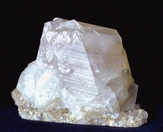
Mineral
Calcite is mined underground. It can be found in New Jersey, Illinois, and Tennessee. It can also be found in Mexico, Germany, India, and England. Calcite comes in a variety of colors. It can be used to make glass, paper, photography, statues, buildings, and animal food. Calcite is the main mineral used to form limestone rock.
Calcite is mined underground. It can be found in New Jersey, Illinois, and Tennessee. It can also be found in Mexico, Germany, India, and England. Calcite comes in a variety of colors. It can be used to make glass, paper, photography, statues, buildings, and animal food. Calcite is the main mineral used to form limestone rock.
Chrysocolla
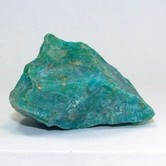
Mineral
Chrysocolla is a beautiful green-blue mineral that can be polished and used for making jewelry. Chrysocolla can be found in the United States in Arizona, Utah, New Mexico and Pennsylvania. It can also be found in other countries around the world, such as: Isreal, Zaire, and England.
Chrysocolla is a beautiful green-blue mineral that can be polished and used for making jewelry. Chrysocolla can be found in the United States in Arizona, Utah, New Mexico and Pennsylvania. It can also be found in other countries around the world, such as: Isreal, Zaire, and England.
Coal

Sedimentary Rock
Coal is made up of plants from a million years ago. First the plants make a layer and then they are pushed down by layers of plants on top of them. This bottom layer becomes something called peat. The layers and layers of plants that keep piling up on top of the peat make it change into coal. Coal can be mined on the surface as well as underground. Coal is used in plastic, papermaking, heat, perfume, rubber, charcoal, roofing shingles, glassmaking, and iron and steel.
Coal is made up of plants from a million years ago. First the plants make a layer and then they are pushed down by layers of plants on top of them. This bottom layer becomes something called peat. The layers and layers of plants that keep piling up on top of the peat make it change into coal. Coal can be mined on the surface as well as underground. Coal is used in plastic, papermaking, heat, perfume, rubber, charcoal, roofing shingles, glassmaking, and iron and steel.
Conglomerate Rock
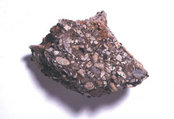
Sedimentary Rock
Conglomerate rocks can be found along beaches, rivers, and glaciers. They look bumpy with bigger rocks cemented together by small gravel and sand. Conglomerate rocks can be used as decoration in a mall or office building. It is not very strong and does not have many other uses besides decoration. Conglomerate rocks are pretty and can have many colors.
Conglomerate rocks can be found along beaches, rivers, and glaciers. They look bumpy with bigger rocks cemented together by small gravel and sand. Conglomerate rocks can be used as decoration in a mall or office building. It is not very strong and does not have many other uses besides decoration. Conglomerate rocks are pretty and can have many colors.
Flourite
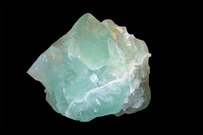
Mineral
Deep purple, amethyst, sky blue, sea green, sunny yellow, and crystal clear—the mineral fluorite comes in all colors. Many types of fluorite even glow under ultraviolet light. They're "fluorescent." Fluorite is the state mineral of Illinois. Flourite is a rare gemstone. It can be used to make jewelry and special optical lenses. It is also used at the dentist's office to protect our teeth from decaying. Flourine, which is made from flourite is also in our drinking water to help protect our teeth too!
Deep purple, amethyst, sky blue, sea green, sunny yellow, and crystal clear—the mineral fluorite comes in all colors. Many types of fluorite even glow under ultraviolet light. They're "fluorescent." Fluorite is the state mineral of Illinois. Flourite is a rare gemstone. It can be used to make jewelry and special optical lenses. It is also used at the dentist's office to protect our teeth from decaying. Flourine, which is made from flourite is also in our drinking water to help protect our teeth too!
Galena
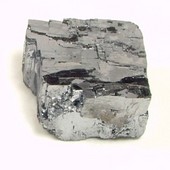
Mineral
Galena is the main mineral used to make lead. It can be mined underground, and is found in Texas, Oklahoma, and Missouri. It can also be found in Germany, Peru, Mexico, Zambia, and England. Galena is used in things that are made out of lead, such as: bullets, batteries, gasoline, and paint.
Galena is the main mineral used to make lead. It can be mined underground, and is found in Texas, Oklahoma, and Missouri. It can also be found in Germany, Peru, Mexico, Zambia, and England. Galena is used in things that are made out of lead, such as: bullets, batteries, gasoline, and paint.
Gneiss
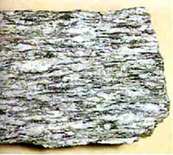
Metamorphic Rock
Gneiss is a rock with streaks of minerals in it. Most of the time, it has feldspar, quartz, and mica in it. Gneiss is formed when there is a lot of pressure and heat, and the rocks melt. It can be mined underground, and can be found all over the world but mostly in mountain ranges like the Andironacks and the Rocky Mountains. It is used in buildings, roads, and curbs.
Gneiss is a rock with streaks of minerals in it. Most of the time, it has feldspar, quartz, and mica in it. Gneiss is formed when there is a lot of pressure and heat, and the rocks melt. It can be mined underground, and can be found all over the world but mostly in mountain ranges like the Andironacks and the Rocky Mountains. It is used in buildings, roads, and curbs.
Granite

Metamorphic Rock
Granite is a rock that is hard and strong. It usually has quarts, mica, and feldspar. It is formed deep down inside the earth from magma that has cooled. Granite is usually pink or white. It is mined in Italy, India, and the United States. It is used to make gravestones and buildings because it is hard and it doesn't break down from being out in the weather. It is also used for kitchen countertops, floor time, curbs, driveways, and in road building.
Granite is a rock that is hard and strong. It usually has quarts, mica, and feldspar. It is formed deep down inside the earth from magma that has cooled. Granite is usually pink or white. It is mined in Italy, India, and the United States. It is used to make gravestones and buildings because it is hard and it doesn't break down from being out in the weather. It is also used for kitchen countertops, floor time, curbs, driveways, and in road building.
Gypsum

Mineral
Gypsum can be found in layers that were formed under salt water many millions of years ago. The water evaporated, and left the minerals behind. It can be mined underground in Utah, Nevada, Colorado, California, and Texas. It can also be found in France, Mexico, and Sicily. Gypsym is used in wallboard, big sheets of a plaster- like substance covered with paper. Wallboard is used to make new walls in buildings. Gypsum is also used in plaster of paris, cement, fertilizer, and ornamental stone. When water is added to gypsum powder, it becomes hard as rock. It is also used to make plaster casts for broken arms and legs.
Gypsum can be found in layers that were formed under salt water many millions of years ago. The water evaporated, and left the minerals behind. It can be mined underground in Utah, Nevada, Colorado, California, and Texas. It can also be found in France, Mexico, and Sicily. Gypsym is used in wallboard, big sheets of a plaster- like substance covered with paper. Wallboard is used to make new walls in buildings. Gypsum is also used in plaster of paris, cement, fertilizer, and ornamental stone. When water is added to gypsum powder, it becomes hard as rock. It is also used to make plaster casts for broken arms and legs.
Honey Calcite
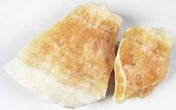
Mineral
Honey Calcite is a type of calcite that is honey colored. See "calcite" to learn more information about calcite.
Honey Calcite is a type of calcite that is honey colored. See "calcite" to learn more information about calcite.
Limestone
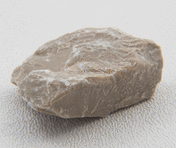
Sedimentary Rock
Limestone most commonly forms in clear, warm, shallow marine waters. It is usually formed from parts of shells, coral, and algae. Limestone can be used to make many things. Most limestone is crushed and used as a construction material. Limestone has many other uses. Powdered limestone is used as a filler in paper, paint, rubber and plastics.
Limestone most commonly forms in clear, warm, shallow marine waters. It is usually formed from parts of shells, coral, and algae. Limestone can be used to make many things. Most limestone is crushed and used as a construction material. Limestone has many other uses. Powdered limestone is used as a filler in paper, paint, rubber and plastics.
Obsidian
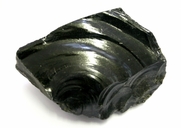
Igneous Rock
Obsidian is formed when volcanic lava comes in contact with water. Often the lava pours into a lake or ocean and is cooled quickly. This process gives obsidian its glassy appearance. Obsidian has been used by ancient people as a cutting tool, for weapons, and for ceremonial purposes, and is sometimes found by archaeologists in excavations.
Obsidian is formed when volcanic lava comes in contact with water. Often the lava pours into a lake or ocean and is cooled quickly. This process gives obsidian its glassy appearance. Obsidian has been used by ancient people as a cutting tool, for weapons, and for ceremonial purposes, and is sometimes found by archaeologists in excavations.
Pumice
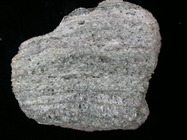
Igneous Rock
Pumice is a rock that is made from volcanic lava. When the lava begins to froth, and flow out of the volcano, it begins to harden. Because pumice contains so many gas bubbles, it is very light and can even float on water! Pumice is abrasive and can be used to exfoliate skin. Ground pumice is also used in finishing furniture.
Pumice is a rock that is made from volcanic lava. When the lava begins to froth, and flow out of the volcano, it begins to harden. Because pumice contains so many gas bubbles, it is very light and can even float on water! Pumice is abrasive and can be used to exfoliate skin. Ground pumice is also used in finishing furniture.
Pyrite
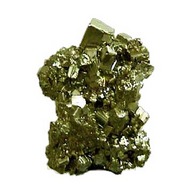
Mineral
Pyrite is also known as "fool's gold" because it looks so much like gold. Many Old West miners were "fooled" into thinking they were rich when they found it. Pyrite is mined underground. It can be dangerous to mine pyrite, because if it combines with water and oxygen, it turns into sulfuric acid and sinks into the ground. Then, it travels into aquifers, rivers, and streams and kills everything in it. After it is mined, it is heated to remove the sulfer and iron. Most pyrite comes from the United States, Italy, Russia, Sweden, and Peru. Pyrite can be used in car batteries, appliances, food cans, paper, tools, some jewelry, and machinery.
Pyrite is also known as "fool's gold" because it looks so much like gold. Many Old West miners were "fooled" into thinking they were rich when they found it. Pyrite is mined underground. It can be dangerous to mine pyrite, because if it combines with water and oxygen, it turns into sulfuric acid and sinks into the ground. Then, it travels into aquifers, rivers, and streams and kills everything in it. After it is mined, it is heated to remove the sulfer and iron. Most pyrite comes from the United States, Italy, Russia, Sweden, and Peru. Pyrite can be used in car batteries, appliances, food cans, paper, tools, some jewelry, and machinery.
Quartz
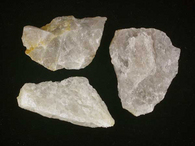
Mineral
Quartz is the most common mineral. Quartz can be found in nearly every type of rock. It can be mined by surface mining, and is mined in Brazil and Arkansas. Wuartz is used in radios, sand paper, soap, prisms, glass, plaints, clocks, watches and computers. It is also used as a crystam gem with which to make beautiful jewelry. It is also used for radar, radios, and TVs because it conducts electricity.
Quartz is the most common mineral. Quartz can be found in nearly every type of rock. It can be mined by surface mining, and is mined in Brazil and Arkansas. Wuartz is used in radios, sand paper, soap, prisms, glass, plaints, clocks, watches and computers. It is also used as a crystam gem with which to make beautiful jewelry. It is also used for radar, radios, and TVs because it conducts electricity.
Sandstone

Sedimentary Rock
Sandstone is composed mainly of feldspar and quartz and varies in color, through grey, yellow, red, and white. Sandstone is often relatively soft and easy to work with, and makes a good building material.
Sandstone is composed mainly of feldspar and quartz and varies in color, through grey, yellow, red, and white. Sandstone is often relatively soft and easy to work with, and makes a good building material.
Scoria
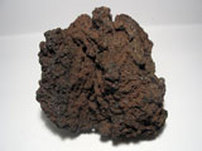
Igneous Rock
Scoria is formed from volcanic lava that pours out of the volcano. When the lava begins to cool, gas bubbles are formed, which gives the rock its texture. Another name for scoria is "cinder." Scoria does not have a lot of uses. In fact, its name comes from a word meaning "waste." However it can be used as an interesting decorative stone with some reddish color. Many people use it for landscaping instead of plants. Some of the large Easter Island statues called Moai have scoria stone in their designs.
Scoria is formed from volcanic lava that pours out of the volcano. When the lava begins to cool, gas bubbles are formed, which gives the rock its texture. Another name for scoria is "cinder." Scoria does not have a lot of uses. In fact, its name comes from a word meaning "waste." However it can be used as an interesting decorative stone with some reddish color. Many people use it for landscaping instead of plants. Some of the large Easter Island statues called Moai have scoria stone in their designs.
Sulfur

Mineral
Sulfer is a mineral that can be found where there are or were volcanoes. It can also be found in salt domes, too. Sulfer is mined underground. Sulfer is mined in Michigan and Ohio. It is also mined in other parts of the world like Sicily, Poland, and Chile. Sulfer is used in papermaking and sulfuric acid. It is also used to make fertilizers, plastics, fireworks, explosives, and matches.
Sulfer is a mineral that can be found where there are or were volcanoes. It can also be found in salt domes, too. Sulfer is mined underground. Sulfer is mined in Michigan and Ohio. It is also mined in other parts of the world like Sicily, Poland, and Chile. Sulfer is used in papermaking and sulfuric acid. It is also used to make fertilizers, plastics, fireworks, explosives, and matches.
Ulexite
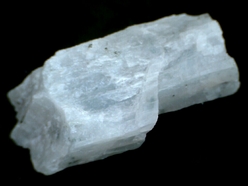
Mineral
Ulexite is usually found in arid places such as California and Nevada. It can also be found in other countries such as: Tarapacam Chile, and Kazakhstan. Ulexite is known as "T.V. rock," because it can transmit an image from one side of the mineral to the other. In other words, if you were to place a piece of ulexite on a newspaper, the writing on the newspaper will appear to be on the top of the mineral without distorting the letters. The newspaper can easily be read on upon the surface of the mineral! This optical phenomenon will stun anyone who has not seen it before. Ulexite is very popular in rock shops, especially with children. Ulexite can decompose in water.
Ulexite is usually found in arid places such as California and Nevada. It can also be found in other countries such as: Tarapacam Chile, and Kazakhstan. Ulexite is known as "T.V. rock," because it can transmit an image from one side of the mineral to the other. In other words, if you were to place a piece of ulexite on a newspaper, the writing on the newspaper will appear to be on the top of the mineral without distorting the letters. The newspaper can easily be read on upon the surface of the mineral! This optical phenomenon will stun anyone who has not seen it before. Ulexite is very popular in rock shops, especially with children. Ulexite can decompose in water.
